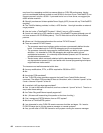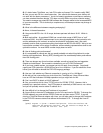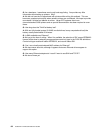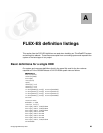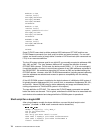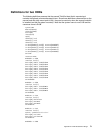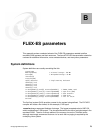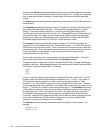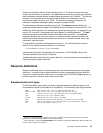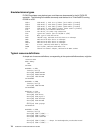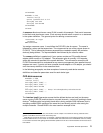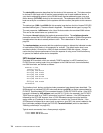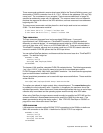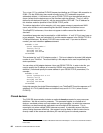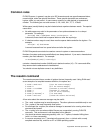74 S/390 PID: ThinkPad Enabled for S/390
The parameter essize specifies expanded storage size and expresses megabytes of storage.
Furthermore, the number specified must be an even multiple of 16. If essize is not specified,
then no expanded storage is emulated. A specification of 64 means 64 MB of expanded
storage.
The instset parameter should always be specified as instset(esa) for the OS/390 systems we
are discussing.
The cachesize parameter specifies the amount of storage to be used by FLEX-ES to cache
dynamically compiled S/390 instructions. This parameter expresses kilobytes of S/390
storage. (The server storage required is 11 times the specified S/390 storage value.)
Practical values are in the range 1024 to 8192. For a Thinkpad/EFS system, 2048 appears to
be a practical value. We suggest you do not use values outside the recommended range
unless you are clearly in an experimental mood. A specification of 2048 means 22 MB of
ThinkPad storage will be used by FLEX-ES for a S/390 instruction cache.
The tracesize parameter specifies the number of entries in a FLEX-ES trace table. We
suggest 512 as a reasonable number for a Thinkpad/EFS system. The FLEX-ES instruction
trace function runs only when started. There is no processor overhead caused by defining a
tracesize parameter. This is a somewhat imprecise parameter because the size of each entry
in the trace table is not well defined. In any event, the total memory used (with the
recommended value) is fairly trivial.
There is also a processor event trace that uses a permanently defined buffer. This event
trace is always active and is not associated with the tracesize parameter.
The cpu parameters indicate the number of emulated S/390 CPUs and assign identification
numbers to each one. Multiple cpu parameters are used to specify multiple emulated S/390
CPUs within a single emulated S/390. For example,
cpu(0)
cpu(1)
cpu(2)
as part of a system definition would specify an emulated S/390 with three CPUs. The CPU
numbers (which are defined S/390 architecture elements) are 0, 1, and 2. The number of
CPUs specified may not exceed the number of server processors enabled for S/390
emulation. For a ThinkPad/EFS system, this will be a single Pentium processor. Therefore,
only one cpu parameter may be specified. (The single CPU may be given any number in the
range 0 - 7, but there is no reason to use anything other than 0.) The dedicated keyword on
a CPU definition statement means that the underlying ThinkPad processor will be used only
for S/390 emulation; it will not be used for Linux work. This option cannot be used with a
ThinkPad/EFS system because only one processor is available for both S/390 and other
Linux work. Netfinity/EFS systems will normally have at least two Server processors and all
but one will be dedicated to S/390 emulation (unless you are running multiple S/390
instances; in that case, the situation is more complex).
The channel parameters specify emulated channels and assign channel numbers. For
example:
channel(3) local
channel(1) local



